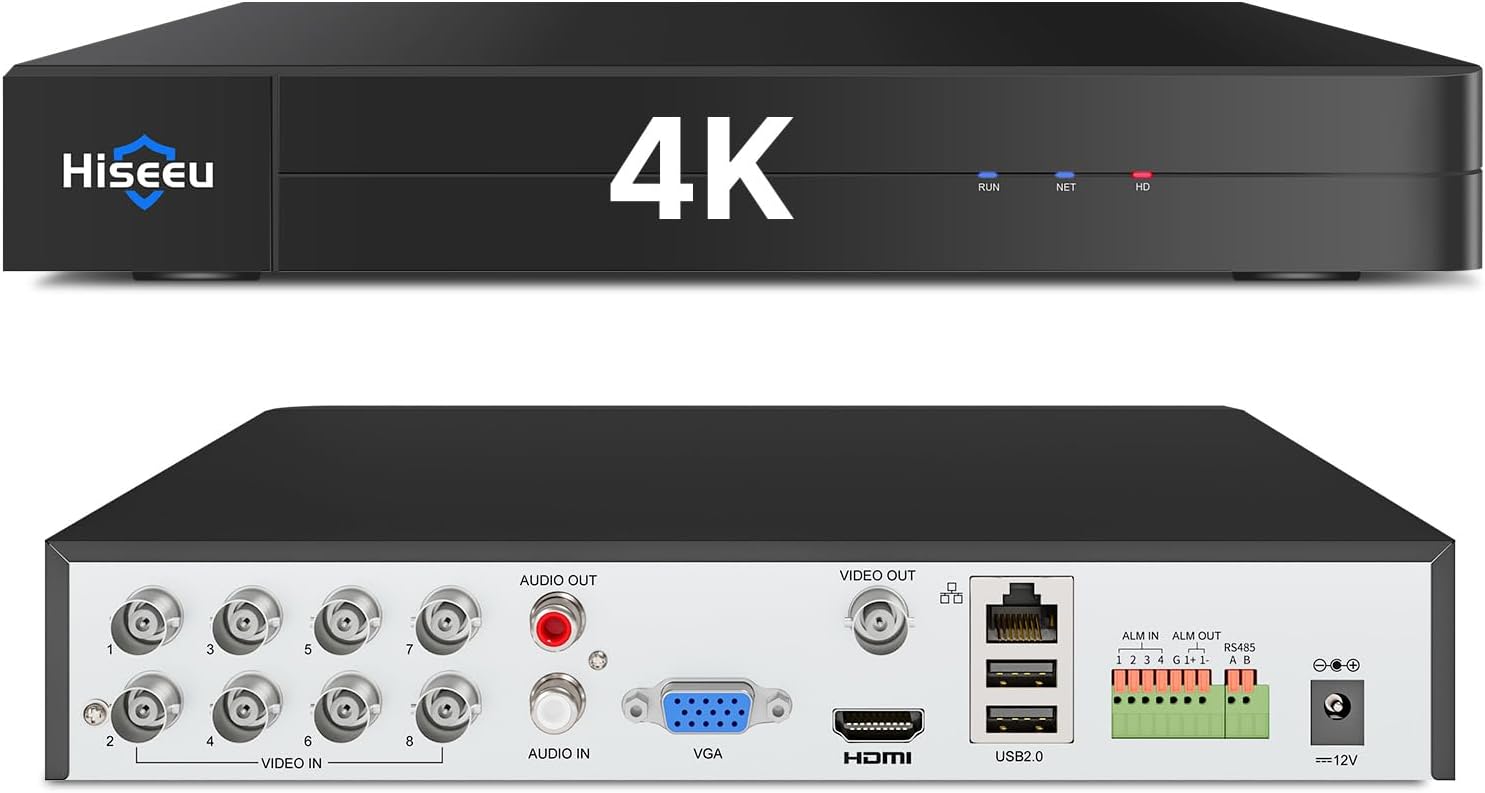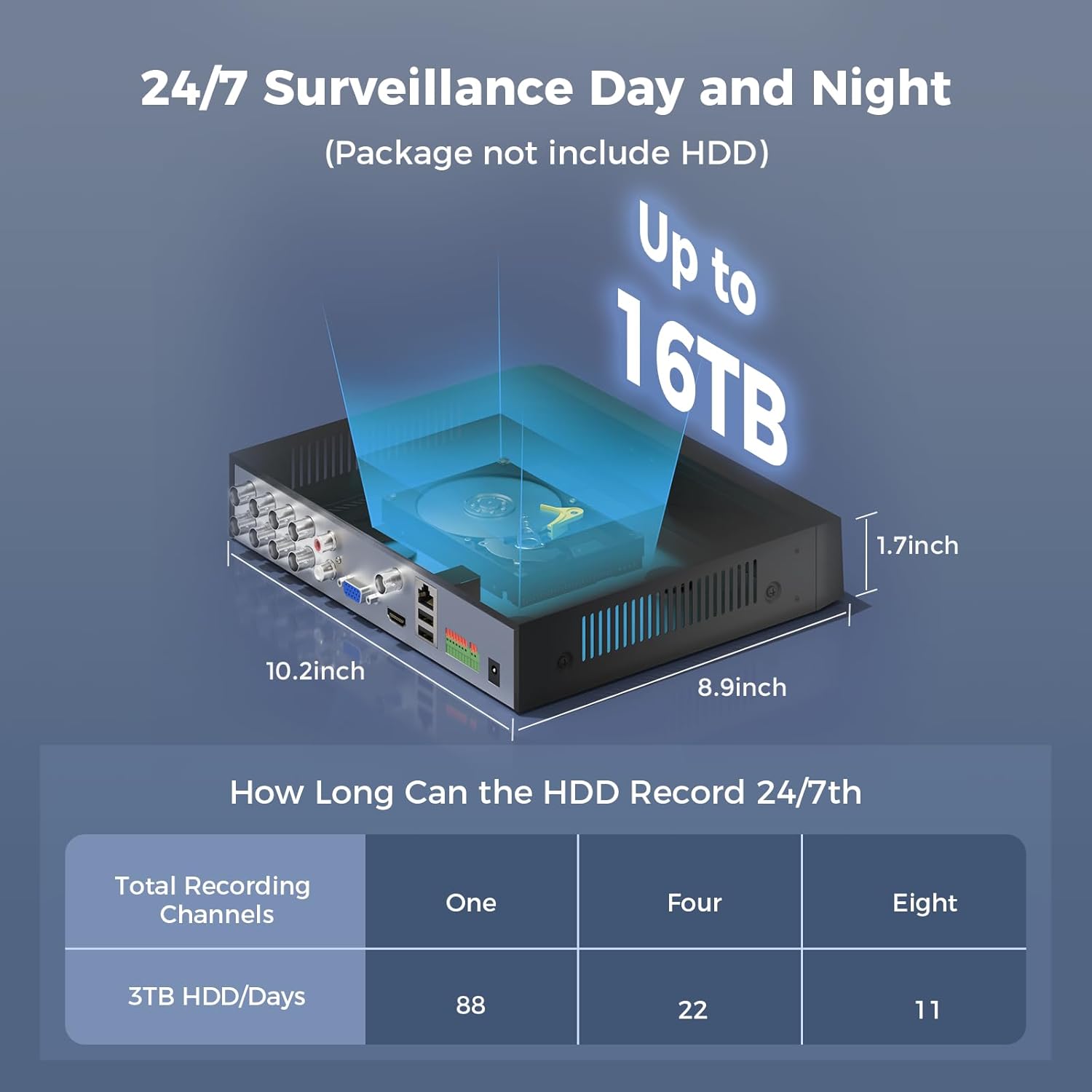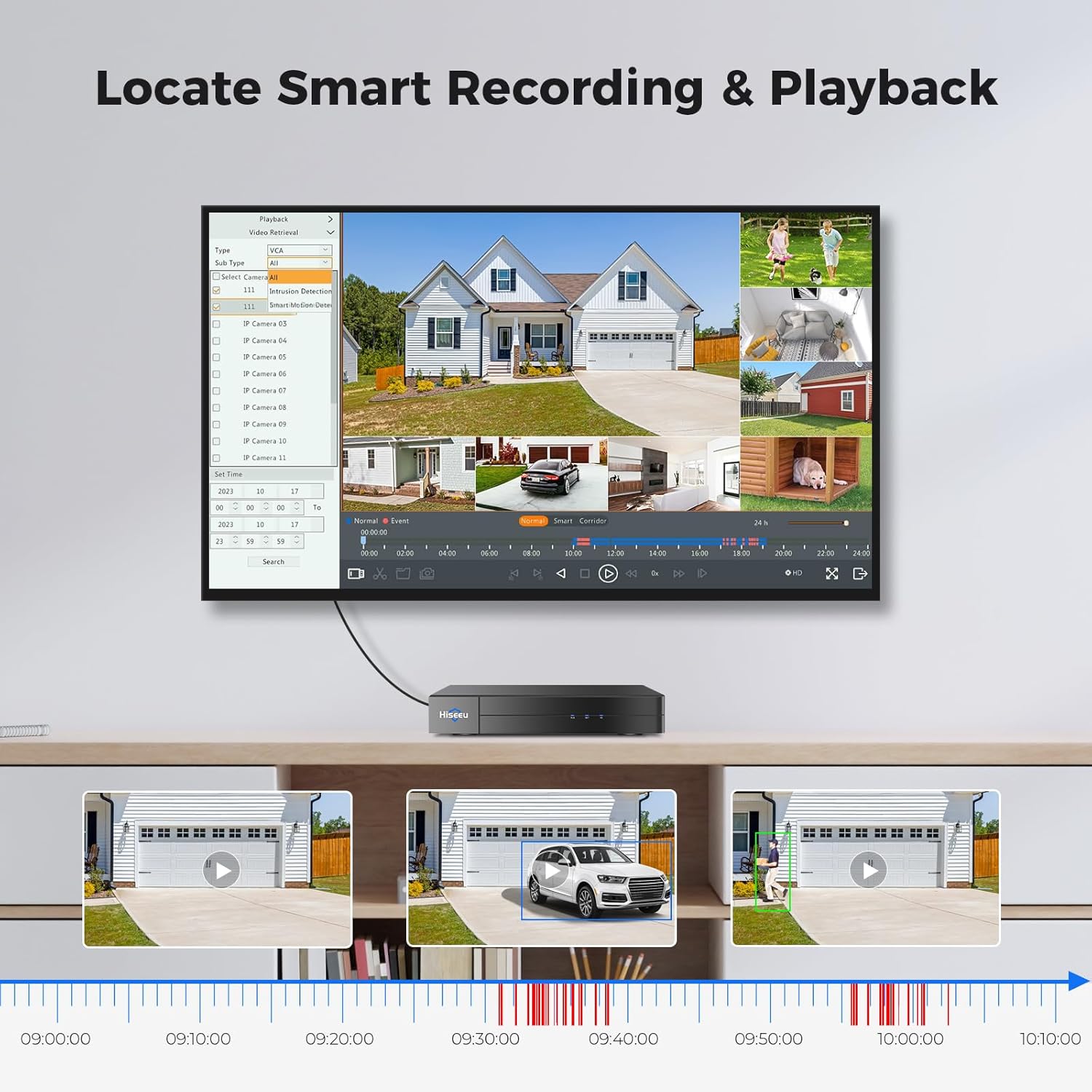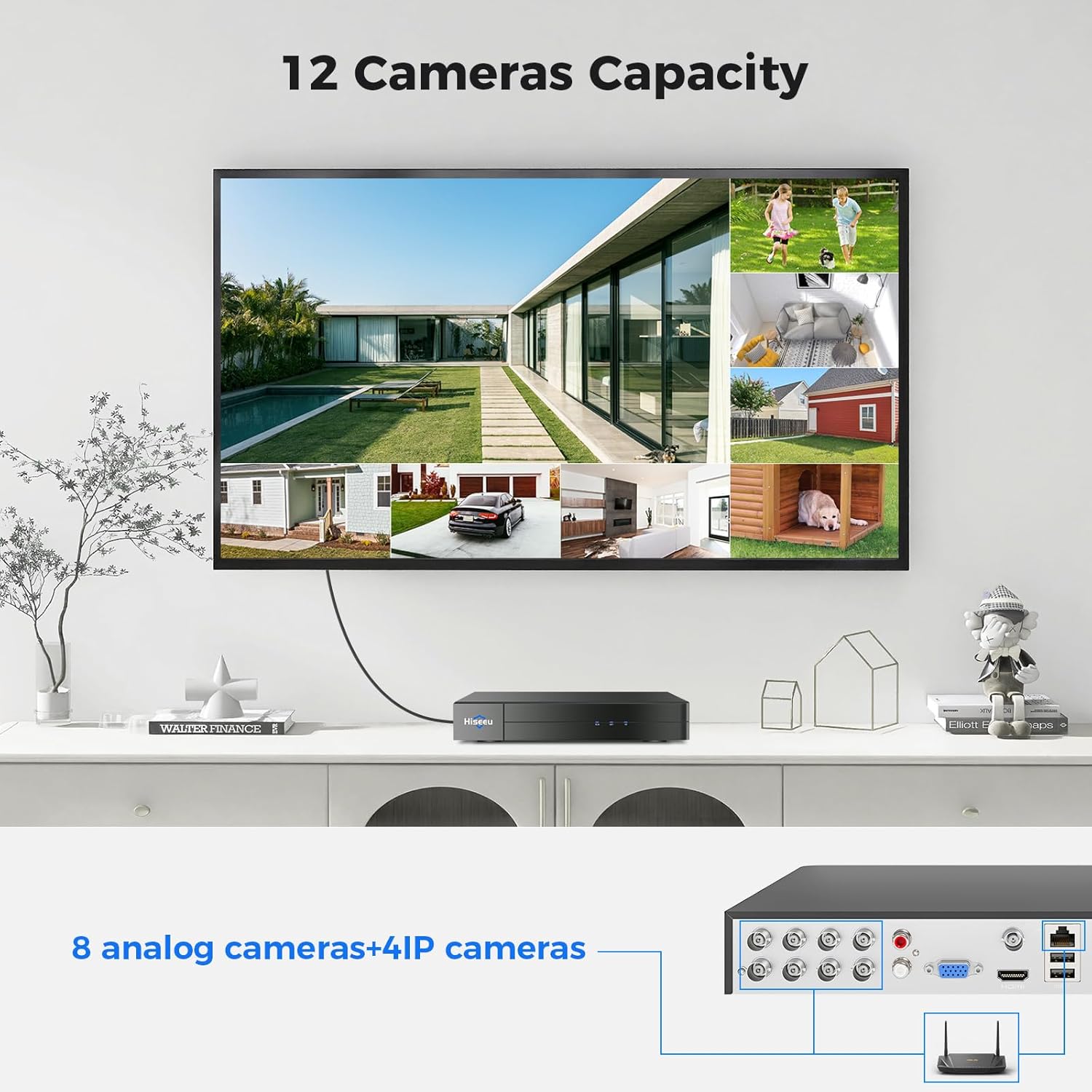?Have you ever thought about what it would feel like to hold a watchful, patient set of eyes on your home that doesn’t ask for a subscription every month?
This image is property of Amazon.com.
First impressions of the Hiseeu 4K 8 Channel DVR Security Digital Video Recorder Advanced 8MP DVR with Person Vehicle Detection for CCTV Security Camera,AHD/TVI/CVI/CVBS/IPC,Remote Access,No Monthly Fee,No Hard Drive
When you unbox this DVR, the first thing you notice is how ordinary it looks — a modest black box, an array of ports like quiet invitations. That ordinary exterior is what you carry into your home: a device meant to attend to ordinary, everyday safety without demanding dramatic changes to your routine.
Design and build quality
The unit’s chassis feels solid in your hands, practical rather than flashy, the kind of thing you tuck under a TV or in a small cabinet. Buttons and ports are arranged plainly; you won’t be dazzled by design, but you’ll appreciate the straightforwardness when you’re setting it up in the evening, tired and wanting things to just work.
What’s included and what you still need
Inside the package you get the DVR unit itself, power adapter, a mouse, instruction manual, and the usual cables — enough to get the device powered and accessed locally. What you do not get is a hard drive: this DVR will not record or play back footage until you add your own HDD. That’s a practical omission: it gives you flexibility, but it’s essential to remember before you depend on the system for surveillance.
Hiseeu 4K 8 Channel DVR Security Digital Video Recorder Advanced 8MP DVR with Person Vehicle Detection for CCTV Security Camera,AHD/TVI/CVI/CVBS/IPC,Remote Access,No Monthly Fee,No Hard Drive
$79.99 In Stock
Technical overview: what this DVR supports
The Hiseeu 4K 8 Channel DVR is a five-in-one hybrid recorder that supports AHD, TVI, CVI, CVBS, and IPC cameras. It handles multiple resolutions and camera types so you can mix analog and IP cameras as you set up your system. You’re given a lot of flexibility, but you’ll want to confirm camera compatibility before buying components.
Supported camera types and encoding modes
This DVR accepts traditional analog formats (AHD/TVI/CVI/CVBS) and IP cameras (IPC). That means if you have older cameras you want to reuse, you can, and if you want to add IP cameras for higher resolution, you can go that way, too. It’s a practical approach that recognizes how systems often grow in pieces over time.
Frame rates and resolution details
The DVR supports:
- 8MP at 15 fps
- 5MP at 20 fps
- 4MP at 30 fps
- 1080P at 30 fps
- 720P at 30 fps
Those numbers mean you can prioritize resolution or smoother motion depending on the camera channel and the scene you’re watching. If you put an 8MP camera on the front door, expect a lower frame rate than on a 4MP camera monitoring a driveway.
Storage and hard drive requirements
This DVR does not include a hard disk drive, and it cannot record or play back without one. You can choose your own HDD up to 16TB, which gives you flexibility in how long you retain footage and how much you’re willing to spend.
No hard drive included — what that means for you
Because the DVR omits a hard drive, you get to decide between budget and capacity: a smaller HDD will keep costs down but shorten retention; a larger drive increases retention but costs more. If you need recommendations, the product listing suggests searching Amazon IDs B07DW4YGYM and B07L3MKQBC for compatible drives.
How much storage might you need?
Storage needs depend on resolution, frame rates, number of cameras, and recording mode (continuous vs. motion-triggered). If you set several cameras to higher resolution and continuous recording, you’ll need more storage. If you use motion detection intelligently, you can keep retention reasonable while still capturing the meaningful events that matter to you.
Compression and video quality
Hiseeu advertises advanced video compression that saves up to 80% more space than H.264. You’ll get sharper footage and smoother streaming, which matters especially when you’re watching remotely or storing long periods of footage.
Advanced video compression: what to expect
The DVR’s newer compression technology reduces file sizes while maintaining visual clarity, which is particularly useful when you record high-resolution streams or manage many channels. That efficiency becomes a practical form of thrift — you keep more footage without necessarily upgrading the hard drive as often.
Balancing quality and storage
You’ll often face a trade-off between high-resolution detail and storage capacity. This DVR eases that tension somewhat, but it doesn’t eliminate it. If you want crisp facial detail at night or to capture license plates from a distance, prioritize camera placement, lighting, and selective high-resolution channels rather than maxing out every channel simultaneously.
This image is property of Amazon.com.
Hybrid functionality and flexibility
This DVR is a true hybrid 5-in-1 unit: it handles AHD, TVI, CVI, CVBS, and IPC. That means you can mix analog and IP cameras in a way that suits the layered realities of your house or business.
Mixing old and new equipment
If you already have analog cameras, you don’t necessarily need to replace them when you upgrade the DVR — you can augment them with new IP cameras. That allows you to address the most important points with newer gear without throwing everything away.
PoE considerations
The DVR supports IP cameras but requires a PoE switch if you want to use PoE cameras. That’s an important practical detail: you’ll need extra equipment and planning for cabling if you want power and data carried over a single Ethernet cable.
Smart AI motion detection and alerts
One of this DVR’s most useful features is smart motion detection. It’s not simply a motion alarm — it aims to distinguish people and vehicles from generic movement, cutting down on false positives.
Person and vehicle detection — how it helps you
The DVR uses AI to send you push alerts only when the system recognizes a human or a vehicle. That means fewer meaningless notifications about leaves in the wind or shadows from clouds, and more alerts you actually care about — someone approaching your doorstep or a car pulling into your driveway.
Setting surveillance areas and privacy masks
You can define specific zones to be more or less sensitive and set privacy masks over areas you don’t want the system to capture. This is valuable when you’re thoughtful about neighbors, public sidewalks, or private windows within range of your cameras.
This image is property of Amazon.com.
Smart playback and event searching
Smart playback is built into the DVR, which makes it easier to find recorded events based on the intelligent motion detection. When you need to review an incident, the system highlights the times when people or vehicles were detected.
How smart playback saves your time
Instead of scrubbing through hours of uneventful footage, smart playback lets you jump to the moments that triggered person/vehicle detection. It feels like the system has a memory tuned to the things that matter to you, saving you time and frustration.
Privacy and data handling when you access recordings
When you use local playback, your footage stays with your device and storage. When you access remotely through the app, remember that you’re streaming sensitive footage over the internet: use strong, unique passwords and keep the device firmware updated to minimize risks.
Remote access and no monthly fees
You can access live streams and recorded footage remotely via the app without paying a monthly subscription. That’s a relief for many users — the DVR’s one-time purchase plus your chosen storage is the main cost.
App access — convenience and occasional friction
The app allows you to view cameras, replay events, and receive push notifications. Expect occasional quirks common to many security apps: updates, network configuration steps, or NAT/router settings that require a bit of patience to get right.
Why no monthly fee matters
No monthly fee means you own the system outright and decide how much to invest in cloud storage, if any. You also won’t face recurring costs for basic functionality, which keeps the system approachable as a long-term solution.
This image is property of Amazon.com.
Support for up to 12 cameras
Although branded as an 8-channel DVR, Hiseeu notes the system can support up to 12 cameras when including IP cameras — up to 8 wired channels plus an extra 4 IP cameras.
Planning a system with mixed cameras
You can build a system that starts with 8 wired cameras and later add IP cameras for key spots. That scalability is useful for growing needs: a new driveway, a backyard entrance, or a detached garage can be covered later without replacing your DVR.
Practical limits and advice
Don’t forget practical limits: bandwidth, recording throughput, and your chosen storage scheme all determine how far you can push the system. If you add multiple high-resolution IP cameras, watch for added load on your network and storage.
Frame rates, real-world usage, and camera placement
The DVR’s supported frame rates and resolutions suggest you’ll need to be deliberate about where you use which cameras. Resolution is important, but placement and lighting matter at least as much for reliable identification.
Choosing which channel gets which resolution
Put higher-resolution cameras where detail matters — front door, driveway, main entrance — and lower-resolution cameras where general monitoring suffices, like a backyard viewed from a distance. The DVR lets you mix these choices channel-by-channel.
Lighting, weather, and nighttime performance
Camera placement that accounts for lighting and weather will give you better results than simply increasing resolution. Consider IR-capable cameras for night, and avoid backlighting that turns faces into silhouettes.
This image is property of Amazon.com.
Interface, local monitoring, and outputs
You can connect the DVR to a TV or monitor for local viewing, and the interface provides access to live and recorded footage. The interface is utilitarian and task-oriented, designed to get you to the footage and settings you need.
Using the local monitor with a mouse
The included mouse lets you navigate menus with reasonable ease, adjusting channels, playback, and settings. For many people, occasional local playback is the simplest and fastest way to review footage.
HDMI and VGA outputs — where to watch
The DVR supports HDMI and VGA outputs, so you can use a modern TV or older monitor. It’s practical and unobtrusive: a small screen in a hallway, a TV you already own, or a dedicated monitor in a home office.
Installation tips and practical setup advice
A good installation increases your odds of getting meaningful footage when it matters. Thoughtful camera placement, cable management, and a plan for power/PoE will save time and trouble later.
Basic wiring and PoE suggestions
If you use PoE cameras, remember the DVR doesn’t include PoE ports — you’ll need a separate PoE switch to power those cameras. Run cables in protective conduits where needed and keep camera housings clean to respect image quality over time.
Securing the DVR and choosing storage rotation
Put the DVR in a locked cabinet or closet if possible, because physical security matters. Plan a recording retention scheme: daily overwriting is fine for general use, but if you expect to hold particular events for evidence, assign those clips to a longer retention schedule or back them up externally.
This image is property of Amazon.com.
Troubleshooting common issues
Even solid devices have moments where they need a little care. You’ll encounter routine problems like network configuration, initial device addition in the app, or camera compatibility quirks.
Network setup hiccups
If you can’t connect remotely, check port forwarding, UPnP settings, and whether your network uses double NAT (common with some ISP setups). Rebooting the router and DVR in sequence often helps.
Camera recognition and compatibility
If a camera isn’t recognized, confirm the camera format (AHD/TVI/CVI/CVBS/IPC), the resolution, and whether PoE is required. Sometimes switching cables or using a different channel will quickly identify if the issue is cable, camera, or DVR.
Warranty and customer service
Hiseeu provides a 12-month warranty for the DVR, and they encourage customers to contact support for issues. That warranty adds reassurance to your purchase: if something fails early, you’re not left entirely on your own.
What to expect when you need help
Expect general tech-support procedures: basic troubleshooting, firmware updates, and service options if a hardware fault is confirmed. Keep your purchase details and serial number handy when you contact support.
When to consider professional installation
If you’re uncomfortable with network or wiring tasks, hiring a professional installer can be worth the cost — it saves time and ensures cameras are positioned and wired correctly for optimal coverage.
This image is property of Amazon.com.
Pros and cons
You’ll weigh practical trade-offs as you build a system. Here’s a balanced breakdown to help you see where this DVR fits your priorities.
| Strengths | Considerations |
|---|---|
| Hybrid 5-in-1 support (AHD/TVI/CVI/CVBS/IPC) offers flexibility for mixed systems | No hard drive included — you need to purchase and install up to 16TB yourself |
| Smart AI person and vehicle detection reduces false alarms | PoE not native — requires PoE switch for PoE cameras |
| Advanced compression saves storage and encourages longer retention | App and network setups can sometimes be fiddly for non-technical users |
| Supports up to 12 cameras (8 channels + 4 IP) for scalability | 8MP max at 15 fps may be limiting for very high-motion scenes |
| No monthly fee for remote access keeps ongoing costs low | Warranty is 12 months — consider extended coverage if you need more |
Who this DVR is for
This DVR suits someone who values flexibility, wants to avoid monthly fees, and is comfortable choosing and installing an HDD. It’s practical for families and small businesses who want a system that can grow over time.
Ideal user scenarios
If you’re upgrading an existing analog system and want to add a few IP cameras, this device is designed for that hybrid approach. It’s also a good fit if you want person/vehicle detection but don’t want to pay subscription fees for cloud services.
When you might want something different
If you prefer an all-cloud solution, a fully PoE NVR with integrated PoE ports, or a device that includes storage and installation, there are alternatives that come with those conveniences at a higher ongoing or upfront cost.
This image is property of Amazon.com.
Comparison with common alternatives
Compared with simple cloud-only camera systems, this DVR gives you local ownership and control, which resonates if you prefer to keep data in your possession. Compared with high-end NVRs, it’s more affordable and flexible, though you may sacrifice some integrated PoE convenience and manufacturer-specific features.
Cost and ownership differences
Cloud systems often appear cheaper early on but add monthly fees; this DVR avoids that recurring cost but requires you to make a one-time purchase for HDD and possible PoE switch. Ownership provides peace of mind in the long run if you value control.
Feature trade-offs
Some competitor NVRs include robust built-in analytics or more integrated cloud options. Hiseeu’s DVR keeps the feature set practical and focused: smart detection, hybrid compatibility, and local control without subscription lock-in.
Practical examples of how people use it
Families often place a mix of cameras: one high-res camera at the front entry, a motion-triggered camera overlooking the driveway, and simpler cameras covering the garage or backyard. Business owners might use the DVR to monitor a small storefront interior and a couple of exterior points of entry.
A day-in-the-life scenario
Imagine you’re at work and receive a push alert that a person was detected at the front door. You open the app, confirm it’s a delivery person, and review the clip to confirm the package location. That small, clear interaction is what the DVR aims to make routine and reliable.
An incident scenario
If your vehicle is hit in your driveway overnight, the vehicle-detection alerts and smart playback can give you a clip that shows license plate motion or the sequence of events, enabling faster police reporting and insurance claims.
Tips to get the most out of your DVR
A few thoughtful choices at setup will keep the system working for you rather than against you. Plan for power, network, camera placement, and how you want to manage recordings.
- Choose the HDD size based on your camera counts and recording preferences; use motion recording where possible to save space.
- Place higher-resolution cameras where the details matter and lower-resolution ones where general monitoring suffices.
- Use privacy masks to respect neighbors and public spaces while keeping your surveillance legal and ethical.
- Secure remote access with strong passwords and keep firmware updated.
- Consider a small uninterrupted power supply (UPS) for the DVR to protect it during brief outages.
Frequently asked questions
You’ll have practical questions when you buy and set up the DVR. Here are short answers to common queries.
Does the DVR include a hard drive?
No. The DVR does not include a hard disk drive. You must install an HDD (up to 16TB). Suggested Amazon HDD model IDs include B07DW4YGYM and B07L3MKQBC.
Can I mix analog and IP cameras?
Yes. The DVR is hybrid and supports AHD, TVI, CVI, CVBS, and IPC, allowing you to mix types as needed.
Do I need PoE to use IP cameras?
If you want to use PoE IP cameras, you will need an external PoE switch. The DVR itself does not provide PoE ports.
Is there a monthly fee for remote access?
No. Remote access via the app is available without a monthly subscription, though storing footage in the cloud (if you choose) may have separate costs.
How many cameras can the DVR support?
Up to 12 cameras: 8 wired channels plus up to 4 extra IP cameras.
Final thoughts
You’ll find the Hiseeu 4K 8 Channel DVR to be a quietly capable piece of equipment: flexible, pragmatic, and designed for practical ownership. It asks you to make a few thoughtful choices — about storage, camera mixes, and placement — and rewards those choices with a system that puts control back in your hands. If you want a solution that respects both your budget and your desire for meaningful alerts, this DVR is a candidate you’ll want to consider.
Disclosure: As an Amazon Associate, I earn from qualifying purchases.











